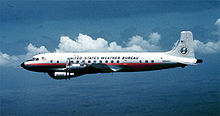Douglas DC-6
| Douglas DC-6 | |
|---|---|
 DC-6 of the Flying Bulls , Bitburg Airfield |
|
| Type: | Passenger and transport aircraft |
| Design country: | |
| Manufacturer: | |
| First flight: |
February 15, 1946 |
| Commissioning: |
November 1946 |
| Production time: |
1946 to 1958 |
| Number of pieces: |
704 |
The Douglas DC-6 is a four-engine American airliner manufactured by the Douglas Aircraft Company from 1946 to 1958 . It was originally planned as a military transport aircraft based on the DC-4 , but was then used as a civil long-range passenger aircraft in competition with the Lockheed Constellation . The DC-6 was the first Douglas aircraft to have a pressurized cabin and, together with the Constellation, was able to replace its predecessor, the DC-4 , particularly on long-haul overseas routes. It was characterized by high economic efficiency and reliability. In total, over 700 aircraft of this type were built and some are still in service today. The DC-6 was eventually developed into the DC-7 , the last Douglas passenger aircraft with piston engines.
In the US Air Force , the DC-6 was called the C-118 Liftmaster , in the US Navy as the R6D .
history
In 1943, the United States Army Air Forces commissioned the Douglas Aircraft Company to build a larger transport machine based on the well-known Douglas DC-4 or C-54 . The project, which began during the Second World War , was given the designation "XC-112". The first flight of the "XC-112" took place on February 15, 1946. The aircraft had a fuselage that was 2.06 meters longer than the DC-4 or C-54. After the end of the war, the US armed forces no longer had a great need for transport aircraft, so Douglas also built a civilian version of the machine and offered it to airlines under the name Douglas DC-6. The civil aircraft made its maiden flight on June 29, 1946. American Airlines ordered fifty planes as its first customer, which were delivered from March 1947 and were initially used in scheduled operations between Chicago and New York . Other major orders followed from United Air Lines and Eastern Air Lines .
After a DC-6 crashed on United Air Lines Flight 608 on October 24, 1947 as a result of a cabin fire and another machine had to make an emergency landing on November 11, 1947 after a fire, the airlines received a recommendation from the Civil Aeronautics Board and did not use the type until the accidents were resolved. The main cause was an incorrectly placed tank vent valve. In addition, the Aircraft Operating Manual lacked precise information on pumping the fuel between the tanks. If the manufacturer did not provide for a transfer to the “Alternate Tanks” near the fuselage , fuel escaped from their ventilation valves, ran along the outside of the fuselage and entered the air conditioning system via an air inlet, where it ignited at the heater. The machines were modified. After that, the DC-6 proved itself with airlines around the world and was considered the most reliable model of the Douglas propeller aircraft after the DC-3 .
Four variants were produced: The extended freight version DC-6A was created from the original DC-6 in 1949 . The most successful version was the passenger aircraft DC-6B, developed from the DC-6A in 1951 . The last civil version was the DC-6C , which allowed either passenger or freight transport.
During the Korean War , the US Air Force also acquired C-118 machines, which were later sold again as civilian machines.
The Air Force One of US President Harry S. Truman was a C-118, The Independence was called. It was the only VC-118 manufactured. The VC-118A and VC-118B were used in the US Air Force and the US Navy for staff transport service.
UN Secretary General Dag Hammarskjöld was killed in the crash of a DC-6B near Ndola on September 18, 1961 .
Today the DC-6 is still used occasionally as a cheap transport aircraft in Alaska , South Africa or South America .
In 2000, the Austrian aviator Siegfried Angerer found the last Douglas DC-6B built from 1958. It had served Marshal Tito as Yugoslavia's presidential aircraft and was also used in Zambia by its president Kenneth Kaunda in the 1970s . The two machines went to Namibia Commercial Aviation in 1992 and 1994, respectively , have been restored and have been used for charter flights within Namibia since then . In 2000 one of the two machines was sold to Flying Bulls in Austria and restored.
A DC-6, which was operated by the Jordanian airline Air Jordan and also flown there by the Jordanian King Hussein , was used as the aircraft café Preussisch Oldendorf from 1969 to 2003 . Today the DC-6 is located in Bad Laer and serves there, among other things, as a temporary registry office.
In 1989 Reinhold Messner and Arved Fuchs landed with a DC-6 in Antarctica and started their hike to the South Pole .
variants

- XC-112
- Name of the US armed forces for an improved C-54 (DC-4), from which the DC-6 prototype emerged. The aircraft had a pressure equalization cabin and four Pratt & Whitney R-2800-CA15 engines, each with an output of 1556 kW (2100 hp). The first flight took place on February 15, 1946.
- DC-6
- Civilian airliner developed from the XC-112, planned for 48 to 52 passengers (with maximum seating up to 86 passengers). The first flight took place on June 29, 1946. The first machine was delivered to American Airlines in March 1947 , which started using it in scheduled service in April 1947.
- DC-6A
- Pure cargo aircraft with a fuselage that is 1.52 meters longer than the basic model, without windows, equipped with a reinforced cabin floor and two cargo doors on the right-hand side. The DC-6A had improved engines with an output of 1760 kW (2400 hp) each and a longer range. The first flight took place on September 29, 1949 (73 machines built).

- DC-6B
- Passenger aircraft with cabin windows based on the DC-6A, planned for 54 passengers (with maximum seating up to 102 passengers), but without a reinforced cabin floor and without cargo doors. The first flight took place on February 2, 1951; the first delivery took place in April 1951 to United Air Lines . Later versions of this type had engines with an output of 1865 kW (2500 hp) each and, in some cases, additional tanks, which meant that the range could be increased. A total of 288 DC-6Bs were built. Two of them were converted by the Belgian airlines Sabena to DC-6B-ST ("Swing tail"), which had a foldable tail and could therefore also be used as cargo aircraft.
- DC-6C
- Was a convertible version that could be used as a passenger or cargo plane. Some machines of the DC-6A series were already delivered from the factory with cabin windows without changing the version designation to DC-6C. It was not until the mid-1950s that Douglas began converting more and more used aircraft from the DC-6A and DC-6B series to optionally transporting cargo or passengers that the name was officially introduced.
- C-118A
- DC-6As built for the United States Air Force , 101
- VC-118
- a DC-6 with 25 seats and 12 beds converted to the US President's aircraft
- VC-118A
- C-118A converted as a VIP transporter
- C-118B (R6D-1)
- DC-6A for the United States Navy , designated R6D-1 before 1962, 65 built
- VC-118B (R6D-1Z)
- four C-118B converted into VIP transporters
Military production
Acceptance of the C-118 / R6D-1 by the USAF / US Navy:
| version | 1947 | 1948 | 1949 | 1950 | 1951 | 1952 | 1953 | 1954 | 1955 | 1956 | TOTAL |
|---|---|---|---|---|---|---|---|---|---|---|---|
| C-112 | 1 | 1 | |||||||||
| VC-118 | 1 | 1 | |||||||||
| C-118A | 17th | 1 | 20th | 61 | 2 | 101 | |||||
| R6D-1 | 8th | 13 | 44 | 65 | |||||||
| TOTAL | 1 | 1 | 0 | 0 | 8th | 30th | 45 | 20th | 61 | 2 | 168 |
About 50 C-118A were converted to VC-118A in 1967.
Incidents
During the service life of the DC-6 from 1947 to January 2019 there were 185 total losses of the aircraft. In 98 of them, 2203 people were killed. In contrast, there were no deaths in 87 of the 185 incidents.
Technical data of the Douglas DC-6B

| Parameter | Data |
|---|---|
| crew | 3 |
| length | 32.18 m |
| span | 35.81 m |
| height | 8.86 m |
| Wing area | 135.9 m² |
| Empty mass | 25,111 kg |
| Max. Takeoff mass | 48,534 kg |
| drive | four double star engines Pratt & Whitney R-2800 Double Wasp (1760 kW / 2400 PS each) |
| Top speed | 580 km / h |
| Cruising speed | 509 km / h |
| normal range | 6240 km |
| Service ceiling | 7620 m |
| Climb performance | 6.1 m / s |
Web links
Individual evidence
- ↑ Namibia Commercial Aviation ( Memento of the original dated February 19, 2008 in the Internet Archive ) Info: The archive link was inserted automatically and has not yet been checked. Please check the original and archive link according to the instructions and then remove this notice.
- ↑ Flying Bulls
- ↑ Statistical Digest of the USAF 1947, p. 17; 1948 II., P. 16; 1949, p. 164 f .; 1951, p. 158; 1952, p. 158; 1953, p. 185 f .; 1954, pp. 70 f .; 1955, p. 80 f .; 1956, p. 91 f.
- ↑ Statistical Digest of the USAF 1967 and 1968, table "US Aircraft Gains and Losses"
- ↑ Accident Statistics Douglas DC-6 , Aviation Safety Network (English), accessed on February 16, 2019.







